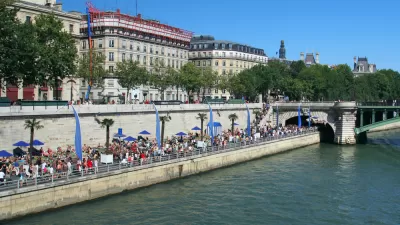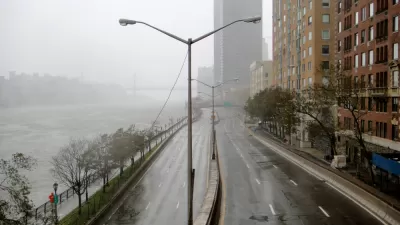Although power has been restored to much of Lower Manhattan, tenants of many of the area's residential and commercial buildings face a long and uncertain recovery before they can return. What will be the long-term effects on waterfront development?
With their lights back on and elevators operating, the easy part of repairing the many commercial and residential buildings in downtown Manhattan that suffered flood damage as a result of Superstorm Sandy is complete. However, according to N. R. Kleinfield, "the full extent of the damage to these buildings, which include major
office towers along Water, State and Front Streets, remains unclear.
Many owners are still furiously pumping out water, some of it
contaminated by toxins."
With "mechanical and
electrical systems destroyed by millions of gallons of water from
swollen rivers," and special cleanups required to clear contaminants, residents and office tenants like the International Planned Parenthood Federation, Morgan Stanley, The Daily News, and the Department of Homeless Services are learning that they may not be able to return to their homes and offices until Thanksgiving, or Christmas, or long after that.
With the potential adverse impacts of living and working near the city's waterfront now clear, Michelle Higgins looks at the prognosis for continued waterfront development. "Although real estate experts say property values are unlikely to suffer
in the long term, it is possible that new zoning and planning
regulations - and buyers' expectations - could reshape how residential
housing along the water is built, marketed and sold."
FULL STORY: Future Is in Limbo for the Damaged Buildings Close to the Water’s Edge

Planetizen Federal Action Tracker
A weekly monitor of how Trump’s orders and actions are impacting planners and planning in America.

Map: Where Senate Republicans Want to Sell Your Public Lands
For public land advocates, the Senate Republicans’ proposal to sell millions of acres of public land in the West is “the biggest fight of their careers.”

Restaurant Patios Were a Pandemic Win — Why Were They so Hard to Keep?
Social distancing requirements and changes in travel patterns prompted cities to pilot new uses for street and sidewalk space. Then it got complicated.

Platform Pilsner: Vancouver Transit Agency Releases... a Beer?
TransLink will receive a portion of every sale of the four-pack.

Toronto Weighs Cheaper Transit, Parking Hikes for Major Events
Special event rates would take effect during large festivals, sports games and concerts to ‘discourage driving, manage congestion and free up space for transit.”

Berlin to Consider Car-Free Zone Larger Than Manhattan
The area bound by the 22-mile Ringbahn would still allow 12 uses of a private automobile per year per person, and several other exemptions.
Urban Design for Planners 1: Software Tools
This six-course series explores essential urban design concepts using open source software and equips planners with the tools they need to participate fully in the urban design process.
Planning for Universal Design
Learn the tools for implementing Universal Design in planning regulations.
Heyer Gruel & Associates PA
JM Goldson LLC
Custer County Colorado
City of Camden Redevelopment Agency
City of Astoria
Transportation Research & Education Center (TREC) at Portland State University
Camden Redevelopment Agency
City of Claremont
Municipality of Princeton (NJ)





























